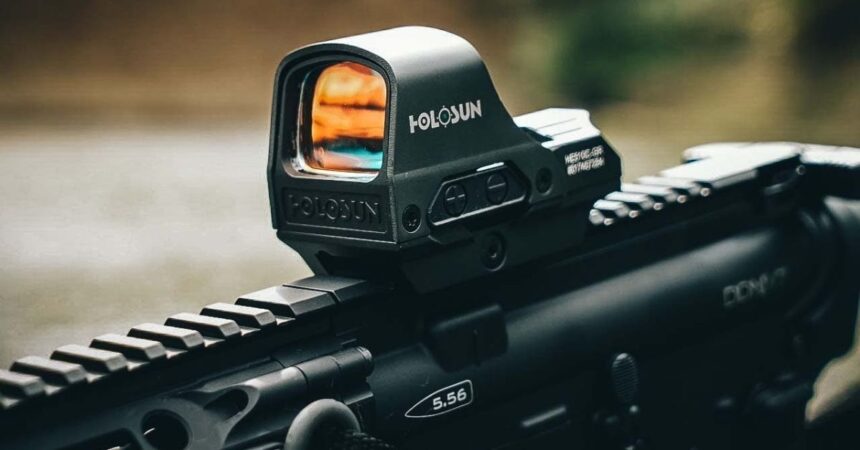Table of Contents:
- Introduction to Red Dot Optics
- How Red Dot Optics Work
- Benefits of Using Red Dot Optics in Shooting
- Different Types of Red Dot Optics
- Choosing the Right Red Dot Optic for Your Needs
- Installation and Maintenance Tips
- Common Misconceptions About Red Dot Optics
- Real-Life Success Stories with Red Dot Optics
Introduction to Red Dot Optics
Red dot optics have profoundly impacted precision shooting by offering features that lead to faster target acquisition and superior accuracy. These optics are designed to streamline the shooting process, eradicating the complexities associated with traditional iron sights. With optic cuts, shooters can seamlessly integrate them into their firearms, enhancing performance and experience. In the contemporary shooting landscape, red dot optics are a staple among sharpshooters of varied disciplines, including competitive sports shooters and tactical operatives. Their ability to provide quick and reliable aiming solutions appeals to many users, from hobbyists to professional snipers. This evolution marks a pivotal shift in shooting technology, making aiming more intuitive and accessible.
How Red Dot Optics Work
The mechanism of red dot optics is elegantly simple yet highly effective. They project a reticle or a small dot onto a lens, enabling shooters to focus solely on their targets without the distraction of aligning multiple sights. This technology employs a reflective or refractive light path to overlay the reticle over the intended target, allowing rapid sight picture acquisition. It minimizes downtime between shots, making it an essential tool for dynamic and high-stakes environments.
Red dot optics eliminate the parallax error standard with iron sights, ensuring that the point of aim remains constant despite changes in eye position. This feature is particularly beneficial in situations requiring speed and agility, translating to better on-field performance for shooters across various levels of expertise.
Benefits of Using Red Dot Optics in Shooting
Speed and Accuracy
The fusion of speed and accuracy is crucial in precision shooting, where milliseconds can determine success. Red dot optics enhance this by offering a singular focus point, allowing for swift, accurate target engagement. Shooters utilizing red dot sights experience rapid engagement and superior accuracy, a significant advantage during competitive shooting events or high-pressure scenarios.
User-Friendly Features
Red dot optics are celebrated for their user-friendly design, which caters to both beginner and expert shooters. They are simple to mount, with most models featuring intuitive adjustments for windage and elevation. This adaptability ensures users can easily tailor the optics to their firearms and shooting styles. Furthermore, their compact, lightweight design makes them an unobtrusive addition that does not encumber the shooter.
Different Types of Red Dot Optics
Reflex Sights
Among the various types of red dot optics, reflex sights stand out for their popularity and effectiveness. They utilize an LED to project a reticle onto a lens without relying on physical alignment with other sight components, thus negating parallax issues. Reflex sights offer a consistent aiming point that remains true regardless of the shooter’s angle of view, a feature highly valued in fast-paced shooting scenarios.
Holographic Sights
Holographic sights leverage laser-based technology to project reticles. Unlike reflex sights, they create an image within the optic, which can accommodate a broader range of visual techniques. It makes them adaptable for various shooting applications, providing flexibility and precision in challenging environments. Their unique projection method also allows for a larger reticle design without sacrificing clarity, which is beneficial in combat and competitive scenarios.
Choosing the Right Red Dot Optic for Your Needs
Selecting the appropriate red dot optic involves assessing several factors, including durability, battery efficiency, and reticle preferences. The choice should align with the shooter’s intended application for recreational use, competitive shooting, or tactical applications. Understanding the differences between optic types and their corresponding benefits can guide shooters toward making informed decisions that enhance their shooting performance.
Installation and Maintenance Tips
Correct installation of red dot optics ensures their performance and longevity. It’s crucial to follow manufacturer guidelines closely to avoid misalignment, which can compromise accuracy. Routine upkeep, including lens cleaning and inspecting for loose mounting screws, is essential to ensure the optics operate at their best. Additionally, guaranteeing intact battery connections can prevent unexpected failures during critical shooting sessions.
Common Misconceptions About Red Dot Optics
Despite widespread adoption, misconceptions about red dot optics persist, particularly concerning their effectiveness at extended ranges. However, innovations in optic design have addressed these concerns. Red dot optics can be practical for long-distance shooting when augmented with additional magnifiers. Such enhancements allow shooters to maintain accuracy across varying distances, debunking common myths about their limitations.
Real-Life Success Stories with Red Dot Optics
Numerous shooting enthusiasts and professionals share testimonials about the transformative impact of red dot optics on their accuracy and confidence. These optics have played a key role in elevating competitive shooting performance and are often credited with helping users achieve new personal bests. Their effectiveness in diverse contexts underscores their value, cementing their place as indispensable tools for anyone serious about precision shooting. In summary, red dot optics symbolize a leap forward in shooting technology, offering unmatched efficiency and precision. Shooters can focus on what truly matters by simplifying the aiming process: hitting their targets. As more individuals discover their benefits, red dot optics are set to become an even more integral part of shooting practices worldwide.





